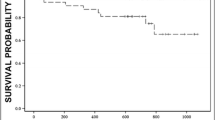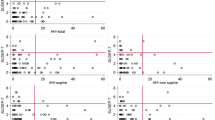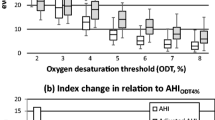Abstract
Purpose
We aimed to evaluate the three hypopnea criteria, A and B from 2007 and the revised from 2012, proposed by the American Academy of Sleep Medicine (AASM) for scoring sleep-related breathing disorders (SRBDs) in patients with acute stroke or transient ischemic attack (TIA).
Methods
Polysomnographies (PSGs) in patients with TIA or stroke were scored according to the A-, B-, and 2012-hypopnea criteria.
Results
Sixty-three PSGs were eligible for hypopnea scoring. There was no difference in the number of patients diagnosed with the B- and 2012-criteria. Therefore, they are mentioned as one. Forty-seven patients (75 %) were diagnosed with SRBD using the A-criteria versus 57 patients (90 %) using the B/2012-criteria (p < 0.0016). In 30 cases, a change from A- to B/2012-criteria resulted in a change in diagnosis. Ten cases of “no SRBD” changed to mild/moderate/severe SRBD. An apnea hypopnea index (AHI) >15 is a typical indication of treatment. With the B/2012-criteria, we found an additional indication of treatment in 18 patients, compared to when the A-criteria were applied (p < 0.0001). Two of these patients were labeled as no SRBD with the A-criteria.
Conclusion
The difference is significant between the AHIs achieved by the A- and the B-/2012-hypopnea criteria, with much lower AHIs achieved with the A-criteria. As SRBD treatment lessens the risk of complications, correct identification of SRBD patients is of the utmost importance.



Similar content being viewed by others
Abbreviations
- AASM:
-
American Academy of Sleep Medicine
- AHI:
-
Apnea hypopnea index
- BMI:
-
Body mass index
- CSA:
-
Central sleep apnea
- CSR:
-
Cheyne-Stokes respiration
- CT:
-
Computed tomography
- EEG:
-
Electroencephalography
- ESS:
-
Epworth Sleepiness Scale
- HI:
-
Hypopnea index
- MRI:
-
Magnetic resonance imaging
- OSA:
-
Obstructive sleep apnea
- PSG:
-
Polysomnography
- SRBD:
-
Sleep-related breathing disorder
- SRCC:
-
Spearman’s rank correlation coefficient
- TIA:
-
Transient ischemic attack
References
Moser NJ, Phillips BA, Berry DT, Harbison L (1994) What is hypopnea, anyway? Chest 105:426–428
Iber C, Ancoli-Israel S, Chessonn A (2007) The AASM manual for the scoring of sleep and associated events: rules, terminology and technical specifications. American Academy of Sleep Medicine, Westchester, IL
Berry RB, Budhiraja R, Gottlieb DJ et al (2012) Rules for scoring respiratory events in sleep: update of the 2007 AASM Manual for the Scoring of Sleep and Associated Events. Deliberations of the Sleep Apnea Definitions Task Force of the American Academy of Sleep Medicine. J Clin Sleep Med 8:597–619. doi:10.5664/jcsm.2172
Yaggi HK, Concato J, Kernan WN, Lichtman JH, Brass LM, Mohsenin V (2005) Obstructive sleep apnea as a risk factor for stroke and death. N Engl J Med 353:2034–2041. doi:10.1056/NEJMoa043104
Young T, Finn L, Peppard PE et al (2008) Sleep disordered breathing and mortality: 18-year follow-up of the Wisconsin sleep cohort. Sleep 31:1071–1078
Ruehland WR, Rochford PD, O’Donoghue FJ, Pierce RJ, Singh P, Thornton AT (2009) The new AASM criteria for scoring hypopneas: impact on the apnea hypopnea index. Sleep 32:150–157
Nerfeldt P, Aoki F, Friberg D (2013) Polygraphy vs. polysomnography: missing osas in symptomatic snorers-a reminder for clinicians. Sleep Breath 18:297–303. doi:10.1007/s11325-013-0884-6
Thornton AT, Singh P, Ruehland WR, Rochford PD (2012) AASM criteria for scoring respiratory events: interaction between apnea sensor and hypopnea definition. Sleep 35:425–432. doi:10.5665/sleep.1710
Guilleminault C, Hagen CC, Huynh NT (2009) Comparison of hypopnea definitions in lean patients with known obstructive sleep apnea hypopnea syndrome (OSAHS). Sleep Breath 13:341–347. doi:10.1007/s11325-009-0253-7
Johnson KG, Johnson DC (2010) Frequency of sleep apnea in stroke and TIA patients: a meta-analysis. J Clin Sleep Med 6:131–137
European Stroke Organization (2008) Guidelines for management of ischaemic stroke and transient ischaemic attack 2008. http://www.congrex-switzerland.com/fileadmin/files/2013/eso-stroke/pdf/ESO08_Guidelines_Original_english.pdf. Accessed 2 Feb 2014
Danish Health and Medicines Authority (2014) Health & treatment/alcohol. Danish Health and Medicines Authority. http://sundhedsstyrelsen.dk/en/health/alcohol. Accessed 10 Feb 2014
Campos-Rodriguez F, Martinez-Garcia MA, de la Cruz-Moron I, Almeida-Gonzalez C, Catalan-Serra P, Montserrat JM (2012) Cardiovascular mortality in women with obstructive sleep apnea with or without continuous positive airway pressure treatment: a cohort study. Ann Intern Med 156:115–122. doi:10.7326/0003-4819-156-2-201201170-00006
Marin JM, Carrizo SJ, Vicente E, Agusti AG (2005) Long-term cardiovascular outcomes in men with obstructive sleep apnoea-hypopnoea with or without treatment with continuous positive airway pressure: an observational study. Lancet 365:1046–1053. doi:10.1016/S0140-6736(05)71141-7
Ward NR, Roldao V, Cowie MR et al (2013) The effect of respiratory scoring on the diagnosis and classification of sleep disordered breathing in chronic heart failure. Sleep 36:1341–1348. doi:10.5665/sleep.2960
Banno K, Okamura K, Kryger MH (2006) Adaptive servo-ventilation in patients with idiopathic Cheyne-Stokes breathing. J Clin Sleep Med 2:181–186
Jennum P, Borgesen SE (1989) Intracranial pressure and obstructive sleep apnea. Chest 95:279–283
Lanfranchi P, Somers VK (2001) Obstructive sleep apnea and vascular disease. Respir Res 2:315–319
Grigg-Damberger MM (2009) The AASM scoring manual: a critical appraisal. Curr Opin Pulm Med 15:540–549. doi:10.1097/MCP.0b013e328331a2bf
Tsai WH, Flemons WW, Whitelaw WA, Remmers JE (1999) A comparison of apnea-hypopnea indices derived from different definitions of hypopnea. Am J Respir Crit Care Med 159:43–48
Hernandez L, Ballester E, Farre R et al (2001) Performance of nasal prongs in sleep studies: spectrum of flow-related events. Chest 119:442–450
Eckert DJ, Malhotra A, Jordan AS (2009) Mechanisms of apnea. Prog Cardiovasc Dis 51:313–323. doi:10.1016/j.pcad.2008.02.003
Ip MS, Lam B, Tang LC, Lauder IJ, Ip TY, Lam WK (2004) A community study of sleep-disordered breathing in middle-aged Chinese women in Hong Kong: prevalence and gender differences. Chest 125:127–134
Acknowledgments
The authors thank sleep technician Mia Dyhr for setting up some of the PSGs for this study and sleep technician Helle Leonthin for discussing difficult scoring cases. We would also like to thank Sune Birch, M.Sc., for the statistical analyses and Margit Graves Ponsaing, M.A., for proof-reading the manuscript. We are also thankful to the Department of Neurology and the Department of Clinical Neurophysiology, Rigshospitalet. There are no conflicts of interest among the authors. The authors have no further financial disclosures to make.
Compliance with ethical standards
As the PSGs were part of a clinical procedure, the Institutional Review Board (Ethics Committee) did not require a written patient consent. Informed, oral consent was obtained from all patients or their next of kin. All procedures performed in studies involving human participants were in accordance with the ethical standards of the institutional and/or national research committee and with the 1964 Helsinki declaration and its later amendments or comparable ethical standards.
Conflict of interest
The authors declare that they have no competing interest.
Author information
Authors and Affiliations
Corresponding author
Rights and permissions
About this article
Cite this article
Ponsaing, L.B., Iversen, H.K. & Jennum, P. Sleep apnea diagnosis varies with the hypopnea criteria applied. Sleep Breath 20, 219–226 (2016). https://doi.org/10.1007/s11325-015-1210-2
Received:
Revised:
Accepted:
Published:
Issue Date:
DOI: https://doi.org/10.1007/s11325-015-1210-2




